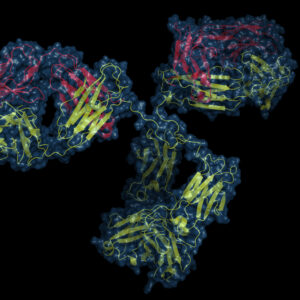Canine Distemper Virus
Canine distemper virus (CDV), also known as Canine morbillivirus, belongs to the Paramyxoviridae family, genus Morbillivirus, and is the etiological agent of canine distemper. It is a highly contagious disease of dogs that affects the respiratory, gastrointestinal and central nervous systems and has a very high mortality rate. The primary mode of transmission is airborne viral particles that dogs breathe in and it has been considered a surrogate model for Measles virus (MeV), which is a closely related morbillivirus. CDV is a worldwide multi-host pathogen and is increasingly found in wildlife species, including carnivores, large felids, marine mammals and non-human primates. There is no specific antiviral drug available for therapeutic use against CDV infection in any species, including domestic dogs. However, there is a vaccine available for domestic dogs which is given as a part of a combination vaccination (DHLPP) that also protects against hepatitis (adenovirus), leptospirosis, parvo and parainfluenza. However, CDV is an emerging pathogen posing a serious threat to the conservation of susceptible captive and free-ranging wildlife populations, and there is a general lack of quantitative data on the effect of CDV vaccination for many of these.
Canine Distemper Virus Background
Canine distemper is a highly contagious, multisystemic viral disease that affects the respiratory, gastrointestinal and central nervous systems of dogs. The first signs of canine distemper include sneezing, coughing and thick mucus coming from the eyes and nose. Fever, lethargy, sudden vomiting and diarrhea, depression and/or loss of appetite are also symptoms of the virus. Canine distemper virus (CDV) also produces immunosuppression in susceptible hosts by targeting cells that express the signalling activation molecule (SLAM)4, which often results in opportunistic infectious diseases caused by agents such as Bordetella bronchiseptica, Candida sp., Clostridium piliforme, Toxoplasma gondii and Dirofilaria immitis (Rendon-Marin et al., 2019). CDV has also been diagnosed concomitantly with other viral infectious disease agents such as canine parvovirus-2 (CPV-2), canid alphaherpesvirus-1, canine adenovirus-1 and -2 (CAdV-1), and (CAdV-2), Canine kobuvirus, Canine pneumovirus, and Canine respiratory coronavirus (Headley et al., 2018).
The disease is caused by the canine distemper virus (CDV) is a large (100–250 nm) single-stranded RNA virus belonging to the genus Morbillivirus of the family Paramyxoviridae. It has a lipoprotein envelope, containing a ~15.6kbp negative-stranded RNA genome containing six genes that code for a single envelope-associated protein [matrix (M)], two glycoproteins [the haemagglutinin (H) and fusion (F) proteins], two transcriptase-associated proteins [phospho-protein (P) and large protein (L)] and the nucleocapsid (N) protein, which encapsulates the viral RNA. Only one serotype of CDV is recognized with several co-circulating genotypes based on variation in the H-protein (Loots et al., 2017).
Canine distemper virus (CDV) i is found in puppies and dogs that have not been vaccinated and infected animals shed the virus through bodily secretions and excretions, especially respiratory secretions. CDV is also common in wildlife and its host range includes species from the order Carnivora (including felids), marine mammals (seals), and non-human primates (rhesus monkey and cynomolgus macaque), often with high mortality rates. CDV clearly exists within a complex reservoir system and how wild animals are exposed to CDV and the role of domestic dogs and wild carnivores in its maintenance and transmission is still not fully understood (Martinez-Gutierrez & Ruiz-Saenz, 2016). This has raised concerns of a potential zoonotic risk of CDV in humans, particularly as CDV is closely related to Measles virus (MeV), another morbillivirus (Loots et al., 2017).
References
- Headley et al. (2018). Canine morbillivirus (canine distemper virus) with concomitant canine adenovirus, canine parvovirus-2, and Neospora caninum in puppies: a retrospective immunohistochemical study. Sci Rep 8, 13477.
- Loots et al. (2017). Advances in canine distemper virus pathogenesis research: a wildlife perspective Journal of General Virology, 98:311–321.
- Martinez-Gutierrez, M., & Ruiz-Saenz, J. (2016). Diversity of susceptible hosts in canine distemper virus infection: a systematic review and data synthesis. BMC veterinary research, 12, 78.
- Rendon-Marin et al. (2019). Tropism and molecular pathogenesis of canine distemper virus. Virol J 16, 30.
Canine Distemper Virus Background
Canine distemper is a highly contagious, multisystemic viral disease that affects the respiratory, gastrointestinal and central nervous systems of dogs. The first signs of canine distemper include sneezing, coughing and thick mucus coming from the eyes and nose. Fever, lethargy, sudden vomiting and diarrhea, depression and/or loss of appetite are also symptoms of the virus. Canine distemper virus (CDV) also produces immunosuppression in susceptible hosts by targeting cells that express the signalling activation molecule (SLAM)4, which often results in opportunistic infectious diseases caused by agents such as Bordetella bronchiseptica, Candida sp., Clostridium piliforme, Toxoplasma gondii and Dirofilaria immitis (Rendon-Marin et al., 2019). CDV has also been diagnosed concomitantly with other viral infectious disease agents such as canine parvovirus-2 (CPV-2), canid alphaherpesvirus-1, canine adenovirus-1 and -2 (CAdV-1), and (CAdV-2), Canine kobuvirus, Canine pneumovirus, and Canine respiratory coronavirus (Headley et al., 2018).
The disease is caused by the canine distemper virus (CDV) is a large (100–250 nm) single-stranded RNA virus belonging to the genus Morbillivirus of the family Paramyxoviridae. It has a lipoprotein envelope, containing a ~15.6kbp negative-stranded RNA genome containing six genes that code for a single envelope-associated protein [matrix (M)], two glycoproteins [the haemagglutinin (H) and fusion (F) proteins], two transcriptase-associated proteins [phospho-protein (P) and large protein (L)] and the nucleocapsid (N) protein, which encapsulates the viral RNA. Only one serotype of CDV is recognized with several co-circulating genotypes based on variation in the H-protein (Loots et al., 2017).
Canine distemper virus (CDV) i is found in puppies and dogs that have not been vaccinated and infected animals shed the virus through bodily secretions and excretions, especially respiratory secretions. CDV is also common in wildlife and its host range includes species from the order Carnivora (including felids), marine mammals (seals), and non-human primates (rhesus monkey and cynomolgus macaque), often with high mortality rates. CDV clearly exists within a complex reservoir system and how wild animals are exposed to CDV and the role of domestic dogs and wild carnivores in its maintenance and transmission is still not fully understood (Martinez-Gutierrez & Ruiz-Saenz, 2016). This has raised concerns of a potential zoonotic risk of CDV in humans, particularly as CDV is closely related to Measles virus (MeV), another morbillivirus (Loots et al., 2017).
References
- Headley et al. (2018). Canine morbillivirus (canine distemper virus) with concomitant canine adenovirus, canine parvovirus-2, and Neospora caninum in puppies: a retrospective immunohistochemical study. Sci Rep 8, 13477.
- Loots et al. (2017). Advances in canine distemper virus pathogenesis research: a wildlife perspective Journal of General Virology, 98:311–321.
- Martinez-Gutierrez, M., & Ruiz-Saenz, J. (2016). Diversity of susceptible hosts in canine distemper virus infection: a systematic review and data synthesis. BMC veterinary research, 12, 78.
- Rendon-Marin et al. (2019). Tropism and molecular pathogenesis of canine distemper virus. Virol J 16, 30.
Canine Distemper Virus Antigens
We are pleased to offer a native Canine Distemper Virus antigen which can be used for sandwich ELISA development and other immunoassays.
Canine Distemper Virus Antibodies
We offer a pair of monoclonal antibodies specific for Canine Distemper Virus surface envelope antigen which can be used as a matched pair for sandwich ELISA development and other immunoassays.
Questions?
Check out our FAQ section for answers to the most frequently asked questions about our website and company.



